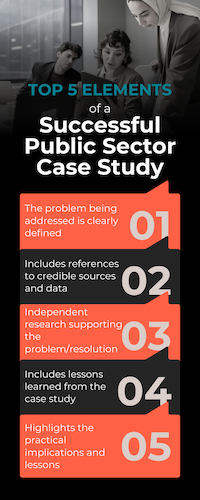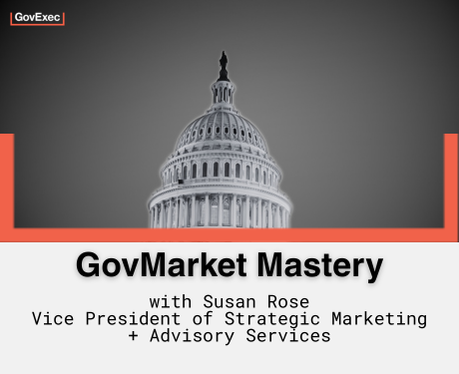Read on for all the details and tips to close the deal.
Why Case Studies Matter (Like, Really Matter)
Government buyers need proof.
They’re risk-averse, accountable to multiple stakeholders (think taxpayers, auditors, elected officials—you get the idea), and focused on evidence-backed solutions. Case studies provide a real-world example of your solution tackling challenges that government agencies can relate to.
Case studies are versatile tools: place them on landing pages, use them in proposals, or offer them as gated content to gather leads.
Done right, they can build credibility, demonstrate impact, and even speed up decision-making.
Let’s look at the five must-have elements every public sector-focused case study needs.
_____
The Five Essentials of a Winning Public Sector Case Study
Our 2024 Content Marketing Review asked what really makes case studies effective for government audiences. Here’s the scoop on the five key elements your case study must have.
1. Start with the Problem—And Make It Crystal Clear
To capture a government decision-maker’s attention, set the stage by identifying the problem. Outline the stakes, the challenges, and the potential fallout of leaving it unresolved.
Example:
If a state agency struggled with outdated IT, don’t just mention “old systems.” Describe how it slowed workflows, raised costs, and risked regulatory compliance. The more vivid the problem, the more relatable it becomes to other agencies facing similar challenges.
2. Back It Up with Credible Sources and Real Data
Credibility is essential. Government buyers need evidence, not claims. Add data points from reputable sources to underscore your story’s weight. Whether it’s statistics from government reports, think tank insights, or real-world data from the agency itself, these details bring credibility and authority.
Example:
If your solution helped a city reduce traffic congestion, share data from the Department of Transportation that backs up the importance of traffic management. Or cite a credible study on how traffic congestion affects economic productivity.
The key is to add weight to your story, making it something decision-makers can take seriously.
3. Bring in Independent Research to Validate the Problem (and Your Solution)
It’s not enough for your company to say, “Our product is awesome.” That’s like saying your own cooking is Michelin-star quality. Get some third-party validation in there. Use independent research to support both the problem and the effectiveness of your solution.
Example:
If a public health department struggled with outdated software for tracking disease outbreaks, citing independent research on the importance of digital health systems adds credibility to your case.
It shows that your solution isn’t just practical; it’s proven essential.
4. Share the Lessons Learned (Because, Yes, There Will Be Some)
No one expects perfection, especially in government projects. Unexpected roadblocks happen, and showing how you addressed them builds credibility and humanity. By sharing lessons learned, you position your team as experienced, adaptable, and committed to continuous improvement. Lessons learned don’t diminish your story; they enhance it.
5. Wrap It Up with Practical Takeaways (a.k.a. the “So What?”)
Your case study shouldn’t just be a one-and-done story. End with actionable takeaways that other agencies can use. Why should your audience care about your case study, and what can they do with this information? Best practices, tips, and relevant strategies turn your case study from a nice read into a valuable resource. This “so what?” factor makes your study compelling and useful.
Show that your company genuinely wants to help the public sector solve its most demanding challenges.
_____
Tips for Using Case Studies to Close the Deal
With a solid case study in hand, here’s how to get the most from it:
- Leverage it across channels: Share it as gated content for lead generation, post highlights on social media, and add it to proposals.
- Make it digestible: Government audiences are busy. Break up the text with bullet points, visuals, and headers.
- Update it regularly: Keep it fresh by revising it with new data and project insights.
The Bottom Line
Case studies are immensely powerful tools. Get the five essentials right: define the problem, back it up with data, add third-party validation, share lessons learned, and close with practical takeaways. You’ll have a case study that tells a story, builds trust, and drives action.
Here are a few award-winning examples produced in partnership with GovExec:
So go ahead and craft that unstoppable case study. In marketing, a great story isn’t just told—it’s sold.
For more information on building unstoppable case studies,
contact Solutions@GovExec.com.



